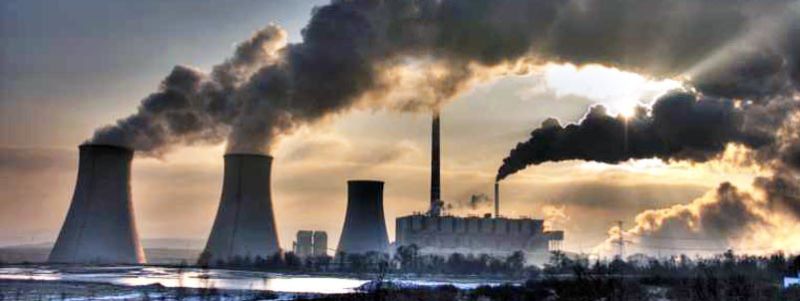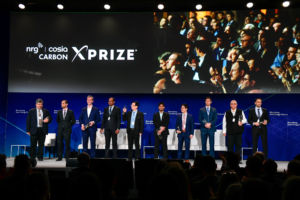Putting CO? to use: 10 finalists named for Carbon XPrize
https://ift.tt/2GRb3dg

On Monday, the XPrize organization announced that it had selected 10 finalists for its NRG COSIA Carbon Competition. These finalists will be given space near a power plant and pipes that will deliver some of the plant’s carbon-dioxide-rich exhaust. It’s up to the competitors to turn that carbon dioxide into marketable products.
For the finalists, those products range from concrete to carbon nanotubes. To get a better overview of the technologies and the competition itself, we talked with Marcius Extavour, the XPrize’s senior director of energy and resources.
Capture, no storage
The world remains committed to fossil fuels, despite our increasing knowledge of the risks they pose. These risks have raised interest in the idea of carbon capture and storage. Rather than shut down our fossil-fuel-burning hardware and all the infrastructure that feeds it, we simply remove the carbon dioxide from the plant’s exhaust, placing it in either long-term storage or reacting it with rocks to lock it away indefinitely.
But doing so costs energy, taking away from the output of the fossil fuel plants and costing money. “Carbon pollution is free today, and this is an expensive technology,” Extavour said. “That’s a fundamental challenge.”
As a result, there have been only a few small-scale tests of carbon capture and storage, and the few plans to expand to full-scale facilities have ended up cancelled. Viewed in that light, it could be difficult to understand what the XPrize hopes to accomplish here.
The answer is quite simple: they’re not doing carbon capture and storage. They’re doing carbon capture and conversion—conversion into products that there’s a market for. The challengers all have processes that can use carbon dioxide as a feedstock. The Carbon Competition is their opportunity to see which of these can scale.
Deployment
For the 10 finalists, the announcement signaled the start of a couple of years of hard work. “We have about another two years of runway for the finalists to scale up by 10x with respect to what they’ve already done,” Extavour told Ars. “A year to build up and test and develop, and another nine months to a year to actually run on site and collect data.”
In this case, “on site” means one of two locations: a natural gas plant in Alberta, Canada or a coal-fired power plant in Wyoming.
Getting the plants’ operators on board was one of the challenges faced by the XPrize itself, Extavour said: “There was a bit of hesitancy at first—we don’t see that type of innovation in the energy industry.”

Prize
The exhaust streams differ in terms of the additional gases present, which could impact any processes that involve catalysts. There’s also a big difference in CO2 concentrations, with the natural gas plant exhaust carrying about five percent CO2, and the coal plant 12 percent. For those teams where this mattered, the XPrize tried to locate them at the appropriate site. But for many of them, the location didn’t matter much. “They need to purify it up to 90 [percent] anyway,” Extavour said.
The projects will be judged based on three sets of criteria. One is related to the goal’s primary task: what percentage of the carbon dioxide that’s sent through the system ends up in some form of product. Related to that, the processes should use more carbon than ends up released from powering them, resulting in a net reduction in emissions. Another set of criteria focus on energy and material efficiency. “How expensive are your catalysts? How much electricity does it cost? How much heat do you need?” Extavour asked. “The teams are competing to minimize the cost and use of materials and energy.”
Also in this category are any land use and resource issues, like water. Both of these, Extavour suggested, may be why there’s only one team that is focused on feeding the carbon dioxide to an organism that would incorporate it into useful molecules. While things like that can be done with photosynthetic algae, it requires a lot of space for growth ponds, as well as significant amounts of water.
The final set of criteria are economic. “It’s about transforming the carbon molecule into something useful,” Extavour told Ars. “Another way of describing useful is valuable or revenue generating.”
But there’s not one path to success on economic terms. One of the teams hopes to produce carbon nanotubes; although their market is small, they command a high price premium. At the other end, a couple of teams are focusing on concrete, where low prices are traded off against an enormous market.
Thermodynamics
Right now, the only use for captured carbon dioxide we’ve come up with is in oil extraction, where it can be pumped underground to force crude to the surface. The projects being pursued here all transform the carbon dioxide chemically. And that means almost all of them run into a big thermodynamic challenge, because carbon dioxide is an extremely stable molecule.
The one exception is carbonates, chemicals that typically involve a metal complexed with the negatively charged CO3 ion. These are energetically favorable compared to carbon dioxide and can find some uses in building materials. But most of the projects involve some sort of energy input to break the carbon-oxygen bonds. “It doesn’t matter where you get the energy from,” Extavour said, “As long as it’s low carbon if you’re trying to lower carbon emissions.”
But he said the plunge in price of renewable power has shifted the economics, and further developments there could open up additional possibilities.

In some cases, the teams explicitly mention using solar power to provide the energy to break down carbon dioxide or to supply the hydrogen to react it with. In other cases, it’s part of a process that we’re already injecting energy into—like making carbon nanotubes, battery components, or plastics.
Ultimately, the price and efficiency will be critical determinants here. Otherwise, it will continue to be more economical to make our plastics from fossil fuels and to expend less energy by using alternate processes. But things like carbon taxes or emissions trading could also tilt things in favor of using carbon dioxide; Extavour spoke of situations where “Energetically, you’re losing, but if you’re focusing on minimizing carbon emissions, you might be winning.”
Why a competition?
If the challenge is a mix of thermodynamics and economics, why would a competition be necessary? For that, Extavour had a number of answers. One is that it could help overcome the (quite reasonable) conservatism of utilities. “I’m familiar with the mandate of ‘do not change anything, do not experiment with anything, do not let the lights flicker,'” he told Ars.
With large-scale demonstration projects, the XPrize could help demonstrate that the technology doesn’t interfere with the primary purpose of these power plants.
There’s also a catch-22 in operation here. These technologies need to be able to scale in order to make any dent in our carbon emissions. But, as Extavour notes, “the free market would never build a test center for the purpose of testing a new technology at industrial scale before the market was mature.”
The XPrize could provide a way out of this catch-22.
Beyond those practical concerns, Extavour sounded a bit like the Solar Impulse team in talking about their round-the-world trip in a solar-powered aircraft—terms like “moonshot” and “inspirational” peppered the conversation. Rather than having people listen to news about carbon capture plans that never get off the ground, “we’re trying to orient people’s minds to think ‘hey, this is possible,'” he told Ars. Two years from now, when the data is collected and analyzed, we’ll have a much better sense of what’s possible.
Tech
via Ars Technica https://arstechnica.com
April 11, 2018 at 10:40AM
